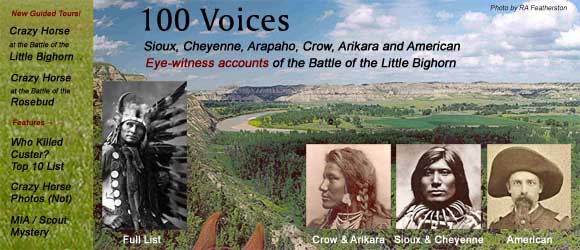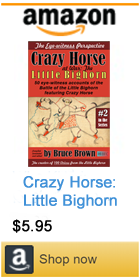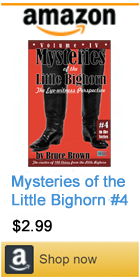|
||||||||||||
Bruce Brown's 100 Voices... George W. Glenn's Story of the Battle #1
THE STORY OF PRIVATE GEORGE W. GLENN
John Smith, post trader at Ft. Lincoln, went as far as Heart River when the expedition started. He set up his sutler's tent when the men were paid and returned at the same time that Mrs. Custer went back. At the mouth of the Rosebud we were camped below the boat and above the timber, on clear ground. Bob Jackson was sent back from the mouth of the Rosebud. I am sure I saw him there in that camp, but do not recall seeing him after that. When we left the Yellowstone each soldier carried on his horse twelve pounds of oats, eighty rounds of ammunition, and two horseshoes, one front and one hind shoe. We overloaded ourselves with ammunition to relieve the pack mules. Many of the men left at the Powder River camp were fellows who played up sick. The officers inquired of the sergeants who were not able to go and such as were thought not to be well and rugged enough were left behind. In each company there was a detail, but there were others who did not want to go, and they pretended to be unwell. In Company H there were none of these, and that is why so few of our company were left there. Jones was killed on the hill by a bullet that passed through several boxes of hardtack. On Reno hill Voigt2 of Company M was killed while trying to untangle horses, being shot through the head. The horses had become frightened and were badly mixed up, and Voigt was exposing his head above the hill. The men called to him to get down, but he did not heed them. I was carrying on my shoulder a box of pistol ammunition up the hill at this time, and before I got to Benteen's line it was struck by two bullets. Just as I got on top of the hill the Indians changed up at us. Benteen called to Reno to send up reinforcements, and so a company came up and reinforced H, and the two companies drove the Indians back. Benteen was on his feet all day June 26, and, it being hot, his shirt tail worked out of his pants and hung down, and he went around that way encouraging the men. He would say "Men, this is a groundhog case; it is live or die with us. We must fight it out with them." Lieutenant Gibson was trying to get out of sight in a pit too shallow and was acting so cowardly that he was in the way of men passing back and forth. Benteen got ashamed of him and told the men to run over him if he persisted in lying there. Martin met us with Cooke's message before we got to the Little Bighorn. When we tried to get to Custer, we looked down (into Medicine Tail coulee) and saw the country thick with Indians, and some of the men said: "Captain, the Indians are getting around us." Benteen said, "Major Reno, we cannot fight them here. We had better fall back and make a stand somewhere." On our way back the Indians did not press us closely. In the valley the bodies of McIntosh and Isaiah lay near together. When Benteen took Company H over to Custer Ridge on 27, he went up to the ridge via Crazy Horse gully. The body nearest the river was that of the chief trumpeter Voss, and near to it was that of Kellogg, the newspaper reporter. Both of these bodies were within a stone's throw of the river. In Crazy Horse gully or washout there were bodies lying thick, and some of the men exclaimed, "Here lies the whole command." Custer's body lay just below the end of the ridge, and within fifity yards of it lay the body of Tom (Boss) Tweed of Company L, who had once been my "bunky" and whom I recognized. His crotch had been split up with an ax and one of his legs thrown up over his shoulder. He was shot with arrows in both eyes. A wounded horse lay near him groaning, and we knocked him in the head with a bloody ax that lay near by, evidently one that had been used by the Indians to cut up or mutilate the wounded. On our way up the Rosebud to meet Crook, a cavalryman's hat was found near the Rosebud.3 I saw the hat. It was a white wool hat, with brass crossed sabers and a brass letter "C."4 It was passed around among the men to see if any one could identify the owner of it. I do not recall that there was any report about a dead man or a dead horse being found with it. When the Indians Passed Poplar River agency going north, they tried to trade a good many watches that they had taken from the bodies of Custer's soldiers. Walter Mason Camp's Notes: 1. Walter Camp field notes, folder 109, BYU Library. George W. Glenn was born in Boston. His third enlistment was on September 3, 1875, under the name of George W. Glease. He deserted on October 15, 1877, and was appre hended on April 26, 1880. He was dishonorably discharged on July 31, 1880, at Fort Meade, Dakota. He later resided in a soldiers' home in Virginia. 3. We quote here from the letter written on July 29, 1908, by Daniel A. Knipe [Kanipe] to Walter Camp: The dead trooper with his gun and dead horse still lariated to the picket pin was found a few days' journey from Custer's hill. It was not six months before his body was found, but was somewheres about three or four weeks. General Cook's command found him. He was over in the Rose Bud country. He was in the direction of about east, or southeast from the battlefield where Custer was found. I knew the man well. His name was Short [Nathan Short], but I do not remember his given name. He belonged to "C" Troop, my company. How I came to know it was Short of my company was that he had his stuff numbered 50, and General Crook reported that the man's number was 50. He was with the company when I left it, on Reno's hill. 4. The following is from the November, 1909, letter from Knipe to Camp: Short wore a light hat with the cross sabres drawn on the front of it with the number "7" between the sabres.... It was a common thing for the men to mark their equipment with their initials for identification. There were very few men in the company who marked their hats as Short did, but I recall very well that he had marked his in this manner. The soldiers all had their hats marked but usually on the inside. I heard Nathan Short's body had been found after we marched from the mouth o/ the Big Horn to the Rosebud, but I did not see the remains. I only heard that the scouts had found them. I did not see anyone who had seen the body, either, but it has always been my understanding that Crook's scouts had found the body, but I have never heard if they were Sioux or Crows who found him. Custer in '76: Walter Camp's Notes on the Custer Fight, edited by Kenneth Hammer, Brigham Young University Press 1976 p 135 - 137
George W. Glenn was also known as George W. Glease. Here is another account of the battle by George Glenn.
|
||||||||||||




 SAYS ISAIAH [Dorman]did not start with the command at Ft. Lincoln, but overtook it on the Rosebud with a message. Said he (Isaiah) had orders to go back, but
SAYS ISAIAH [Dorman]did not start with the command at Ft. Lincoln, but overtook it on the Rosebud with a message. Said he (Isaiah) had orders to go back, but 







